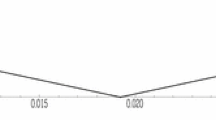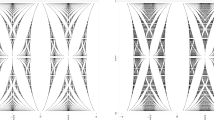Abstract
The observation in the title made earlier in association with the Pais–Uhlenbeck oscillator with equal frequencies is illustrated for an elementary matrix model. In the limit \(N \to \infty \) (N being the order of the exceptional point), an infinity of nontrivial states that do not change their norm during evolution appear. These states have real energies lying in a continuous interval. The norm of the “precursors” of these states at large finite N is not conserved, but the characteristic time scale where this nonconservation shows up grows linearly with N.

Similar content being viewed by others
Notes
The fact that the Hamiltonian of the PU oscillator with equal frequencies has a real continuous spectrum (which, however, is not bounded from below, nor from above) was actually known since the original Pais and Uhlenbeck paper. We can also refer the reader to more recent [5] for a nice detailed analysis of this issue.
A more complicated matrix model for multiple exceptional points was earlier suggested in [9].
In this limit, the Hamiltonian (5) coincides after a similarity transformation with the annihilation operator of a harmonic oscillator,
$$\begin{array}{@{}rcl@{}} a \ =\ \left( \begin{array} {cccccc} 0 & 1 & 0 & 0 & {\cdots} & 0 \\ 0 & 0 & \sqrt{2} & 0 & {\cdots} & 0 \\ 0 & 0 & 0 & \sqrt{3} & {\cdots} & 0 \\ {\cdots} & {\cdots} & {\cdots} & {\cdots} & {\cdots} & \cdots \end{array} \right) \, . \end{array} $$(15)The eigenstates (14) are then nothing but coherent states. To avoid confusion, bear in mind, however, that, unlike the annihilation operator (15), the Hamiltonian (5) is responsible, as any Hamiltonian is, for the time evolution of the system.
The Hilbert space of the Hamiltonian (17) has two sectors with the functions even and odd under x→−x. Correspondingly, we have here two Jordan ladders.
To rigorously justify this numerical observation is an interesting problem for a mathematics student.
References
Heiss, W.D.: J. Phys. A 37, 2455 (2004). quant-ph/0304152
Pais, A., Uhlenbeck, G.E.: Phys. Rev. 79, 145 (1950)
Smilga, A.V.: Phys. Lett. B 632, 433 (2006). hep-th/0503213
Smilga, A.V.: SIGMA 5, 017 (2009). arXiv: 0808.0139[quant-ph]
Bolonek, K., Kosinski, P.: quant-ph/0612009
Bender, C., Mannheim, P.: Phys. Rev. Lett. 100, 110402 (2008). arXiv: 0706.0207[hep-th]
Bender, C., Mannheim, P.: Phys. Rev. D 78, 025022 (2008). arXiv: 0804.4190[hep-th]
Heiss, W.D.: talk at the Int. Conf. PHHQP-14, Setif (Algeria), Sept. 5-10 (2014)
Znojil, M.: J. Phys. A 40, 4863 (2007). math-ph/0703070
Scholtz, F.G., Geyer, H.B., Hahne, F.J.W.: Ann. Phys. (NY) 213 (1992) 74; C.M. Bender and S. Boettcher, Phys. Rev. Lett. 80 (1998) 5243, physics/9712001; A. Mostafazadeh, J. Math. Phys. 43 (2002) 2814, math-ph/0110006
Levai, G., Ruzicka, F., Znojil, M.: Int J. Theor. Phys. 53, 2875 (2014). arXiv: 1403.0723[quant-ph]
Author information
Authors and Affiliations
Corresponding author
Additional information
Dedicated to the people of Novorossia
Appendix
Appendix
We explain here why an attempt to construct a sequence of crypto-Hermitian matrix Hamiltonians with the same limit \(N \to \infty \) as the limit H ∗ of the Hamiltonians (5) fails.
Consider the normalized eigenstates of H ∗, \(|\epsilon \rangle : a_{j} = \sqrt {1-\epsilon ^{2}} \, \epsilon ^{j} \) with real 𝜖∈(−1,1). We have
Consider now a set of N=2M+1N-dimensional unitary vectors |n=−M,…,0,…,M〉 with the inner products
For example, for M=1, we choose
Obviously, (A.2) represents a discretization of (A.1).
At the next step, we construct the matrix \((\tilde H)_{N}\) having the vectors |n〉 as eigenvectors with eigenvalues 𝜖 n . This is possible to do as long as the system of N 2 equations
for the matrix elements \( ({\tilde H}_{N})_{ij}\) is not degenerate. In other words, as long as the vectors |n〉 are linearly independent and the determinant of the N×N matrix made of the vector components does not vanish. For M=1, this determinant is equal to 0.2. This indicates that, though the vectors (A.3) are not coplanar, they are relatively close to being so. Finally, one can make these vectors orthogonal by redefining the norm in an appropriate way.
However, the larger M and N are, the more difficult is to carry on this program. It is more convenient to study not the determinant of the eigenvector components, but its square, the Gram determinant of the matrix of their scalar products. For M=1, the Gram deteminant Δ1 of the scalar products (A.2) is equal to 0.04. For M=2, it is equal to 10−5, meaning that the corresponding five eigenvectors are “almost” linearly dependent. For M=3, it is already 10−11. It roughly decays as \({\Delta }_{M} \sim e^{-1.2M^{2}}\).Footnote 5 A matrix with an almost degenerate system of eigenvectors must have very large elements. The limit \(N \to \infty \) is singular.
Rights and permissions
About this article
Cite this article
Smilga, A. Exceptional Points of Infinite Order Giving a Continuous Spectrum. Int J Theor Phys 54, 3900–3906 (2015). https://doi.org/10.1007/s10773-014-2404-2
Received:
Accepted:
Published:
Issue Date:
DOI: https://doi.org/10.1007/s10773-014-2404-2




